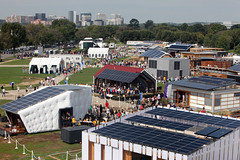If the US Department of energy its first Solar Decathlon on the National Mall in 2002 instead of American energy issues grew nervous for the first time in decades. Natural gas prices had skyrocketed, California had recovered just from rolling blackouts and the events of 9/11 and our continued dependence on foreign sources of energy were foremost in our minds.
In the meantime as America his drop in rankings in mathematics and the sciences, request for stem (science, technology, engineering and mathematics) skilled workers increased to the point that the STALK grew three times faster than other positions jobs. While we lag behind many Asian and European countries stem areas, there were advance studies in the fields of STEM a growing movement in education policy and curriculum elementary school and college-level, to improve the competitiveness of the United States in these areas intended.
Energy and education met in this timed Solar Decathlon in Washington, D.C., culminating in more than a dozen solar 2002 apartments temporarily erected in front of the Capitol and toured driven by thousands of visitors from all over the world. Office of energy efficiency and renewable energy solar technology program made possible, reinforced this new, experimental program outside the traditional work of the DOE through the initiative of Dr. Richard King, and together moved to college students from different academic fields of architecture, engineering, natural sciences, communications, interior design and others - the most cost effective, attractive, and energy efficient solar-powered home.
Decathlon used a "If you build it, they will come" - bring strategy, the solar energy as a viable solution for our energy and education challenges in the foreground: when you train and encourage innovative thinkers to the students, the students will turn in educating the public about affordable renewable energy systems available today. The program encourages innovation while driving product awareness, promotes growth in new markets; In the meantime require promoting STEM skills in our students, the creative integration with other areas. The most important physics had to work hand in hand to make the landscape gardener, the home function as a system.
The prosperity and the Solar Decathlon to reach over the past decade (there are programs in China and Europe the Solar Decathlon now), as well as larger programs such as the SunShot initiative that 2011 has funded since the beginning, more than 150 solar technology work to leverage private dollars and innovations. Leaving alive their birthplace of Washington, for the first time, biennial Solar Decathlon will start in California this year with a bevy of collegiate teams from around the nation - and worldwide - presented like solar's role in the diversification of the energy mix of the country and growing.
With 120,000 Americans at more than 5,600 enterprises builds the U.S. solar industry helps our houses and shops makes; and presented by the new technologies and designs on the Solar Decathlon, it is clear that the United States is a global competitors - both in education and solar deployment.
Ask the way, as she and her team their solar house for this competition planned every hard-working students at the Solar Decathlon in Orange County, and between the talk of blinds you hear a themed panels, LEDs, light, and water treatment,: it is built to win. And this is good news for all of us.
The information and opinions in this blog are solely those of the author and not necessarily the RenewableEnergyWorld.com and company, the advertising on this Web site and other publications. This blog has been posted directly by the author and has not been reviewed for accuracy, spelling or grammar.
View the original article here
Saturday, August 31, 2013
Solar Decathlon: Spotlighting American innovation
на 11:34 AM Saturday, August 31, 2013Ярлыки: American, Decathlon, Innovation, solar, Spotlighting
Subscribe to:
Post Comments (Atom)

0 коммент.:
Post a Comment